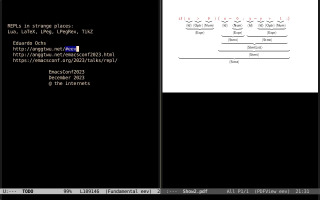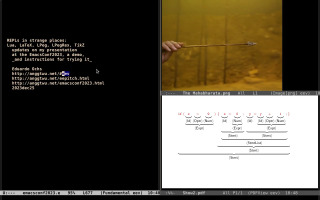Eev @ EmacsConf 2023: REPLs in strange places
This is what I presented at the EmacsConf 2023.
Here are links to the full schedule of the
conference and to my talk in it.
My presentation had several problems,
and I tried to fix them by recording a second video.
You can read the subtitles of the two videos here
and here.
The instructions from trying the programs are here: (find-show2-intro).
Title:
REPLs in strange places: Lua, LaTeX, LPeg, LPegRex, TikZAbstract:
Many years ago, when I started programming, my dream was to write games. I failed miserably in that, but I became fascinated by languages, and I discovered Forth - that was perfect for writing languages whose syntax was as simple as possible. Then I switched to GNU/Linux and I had a series of favorite languages; at some point I discovered Lua, that became not only my favorite language but also my favorite tool for implementing other languages. One of the main libraries of Lua is something called LPeg, that lets "people" implement complex parsers in just a few lines of code using PEGs - Parsing Expression Grammars.I've put the "people" in the last paragraph between quotes because for many years I wasn't included in the "people who can implement complex parsers with LPeg"... lots of things in LPeg didn't make sense to me, and I couldn't visualize how it worked. Something was missing - some diagrams, maybe?
The main tool for drawing diagrams in LaTeX is something called TikZ, that is HUGE - its manual has over 1000 pages. TikZ includes lots of libraries and extensions, and each one of these libraries and extensions extends TikZ's core language with some extra constructs.
I don't know anyone - except for a handful of experts - who knows what is the "core language" of Tikz, that lies, or that should lie, below all these extensions... all of my friends who use TikZ are just "users" of TikZ - they've learned some parts of TikZ by starting with exemples, and by then modifying these examples mostly by trial and error. In particular, no one among my friends knows how styles in TikZ really work; styles are implemented using "keys", that are hard to inspect from a running TeX - see [1] - and I found the chapter on "key management" in the manual very hard to understand. It feels as if something is missing from it... some diagrams, maybe?
In my day job I am a mathematician. I work in a federal university in Brazil, and besides teaching I do some research - mostly in areas in which the papers and theses have lots of diagrams, of many different kinds, and in which people use zillions of different programs to draw their diagrams. Every time that I see those diagrams I think "wow, I need to learn how to draw diagrams like that!", but until a few months ago this seemed to be impossible, or very hard, or very painful...
This presentation will be about a point in which all these ideas intersect. I am the author of an Emacs package called eev, that encourages using REPLs in a certain way; Lua can be used in several different styles, and if we use it in a certain way that most people hate - with lots of globals, and with an implementation of OO that makes everything inspectable and modifiable - then it becomes very REPL-friendly; there is an extension of LPeg called LPegRex ([2], [3]), that I found promising but hard to use, so I rewrote some parts of it to make them more REPL-friendly, and to make it print its ASTs in 2D ASCII art. The core of my presentation will be about how I am using REPLs written in Lua to write grammars, parsers, and tools to generate many kinds of diagrams, and how I am using these diagrams to document both my own code and other people's programs - the parts of them in which some diagrams seem to be missing. My hope is that people will find these ideas easy to port to other languages besides Lua, to other tools for generating diagrams besides LaTeX - SVG, maybe? - and to other ways to use REPLs in Emacs besides eev. Some ideas in this presentation were inspired by the blog post [4].
1. https://tex.stackexchange.com/questions/663740/alternative-to-edef-c-pgfkeys-a
2. https://github.com/edubart/lpegrex
3. https://github.com/edubart/lpegrex/blob/main/parsers/lua.lua
4. https://ianthehenry.com/posts/my-kind-of-repl/
Problems
This ended up being a very strange presentation. Due to personal problems I was only able to finish the programs that I wanted to present two days before the EmacsConf, and I recorded the video without rehearsing it much... and the video ended up being about languages and tools that few Emacsers use, and that I use in unusual - but very REPL-friendly - ways, and the rationale behind these REPL-friendly ways.
Here are some things that I consider that are missing from the video:
- Eepitch blocks are like Org ":session"s, but without black boxes
- A comparison with Roberto Ierusalimschy's "Building a Programming Language" (Reddit, videos)
- How to start from underbrace diagrams and then build a grammar
- How to install the programs from the git repository
(More soon!!!)

